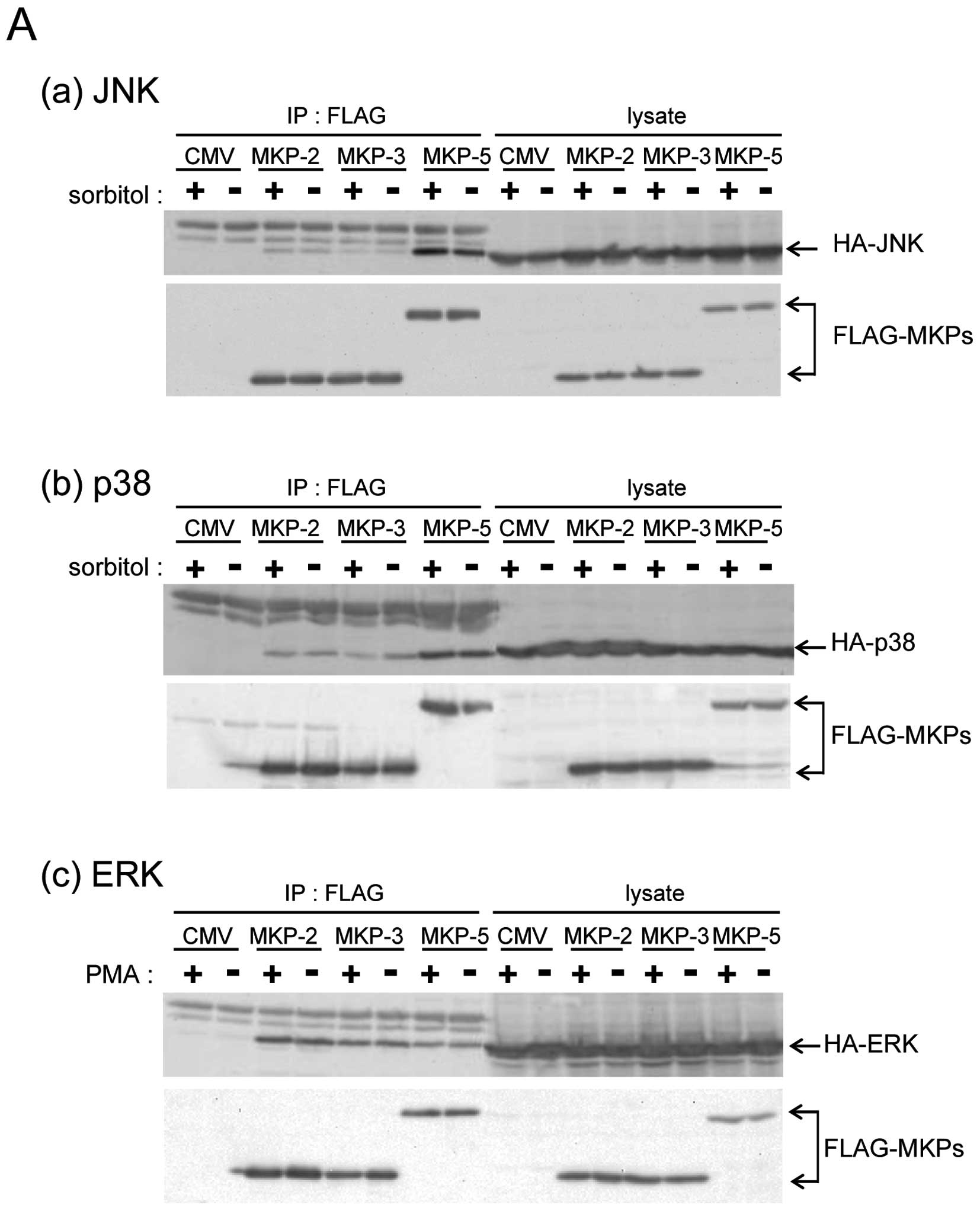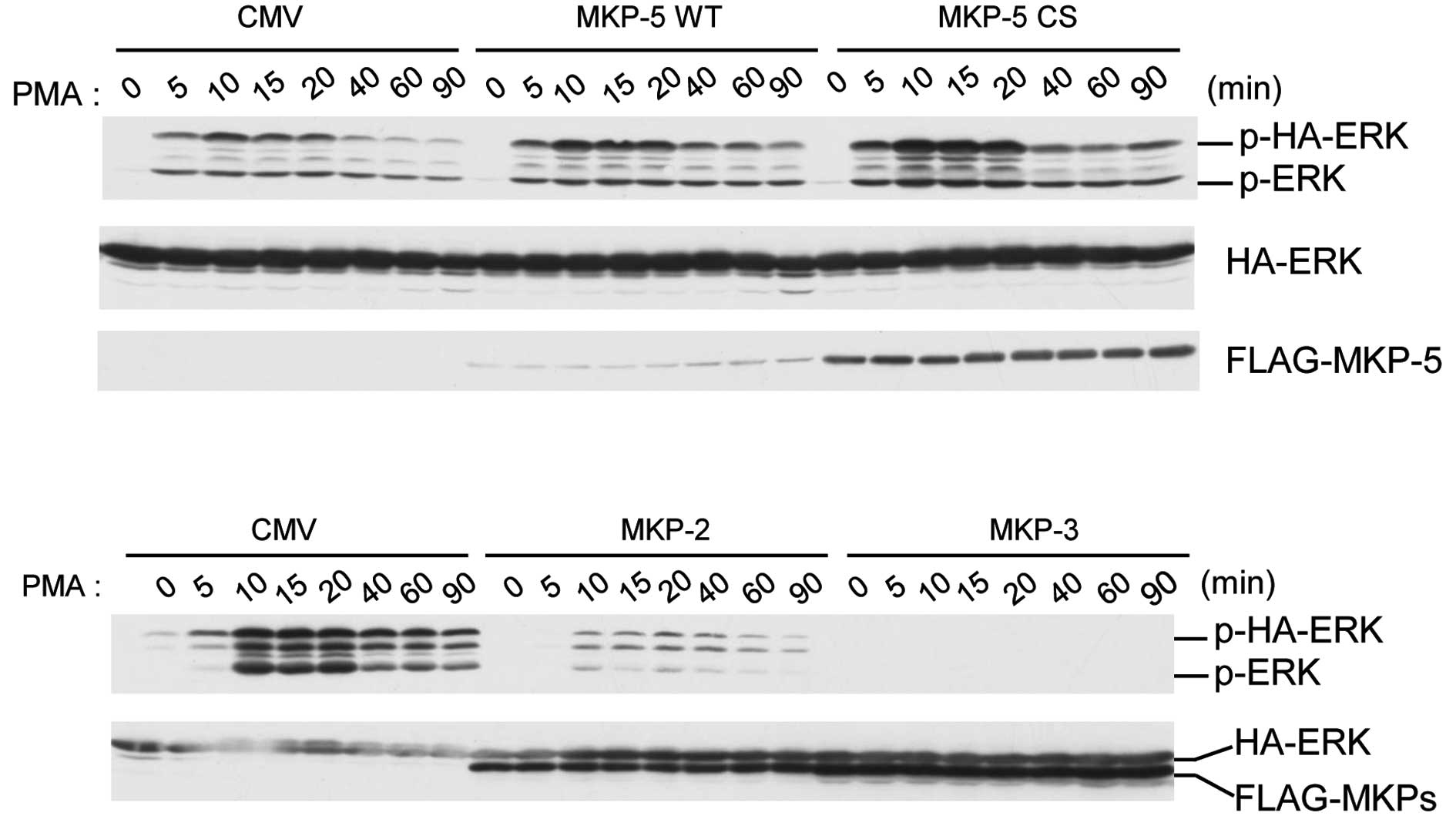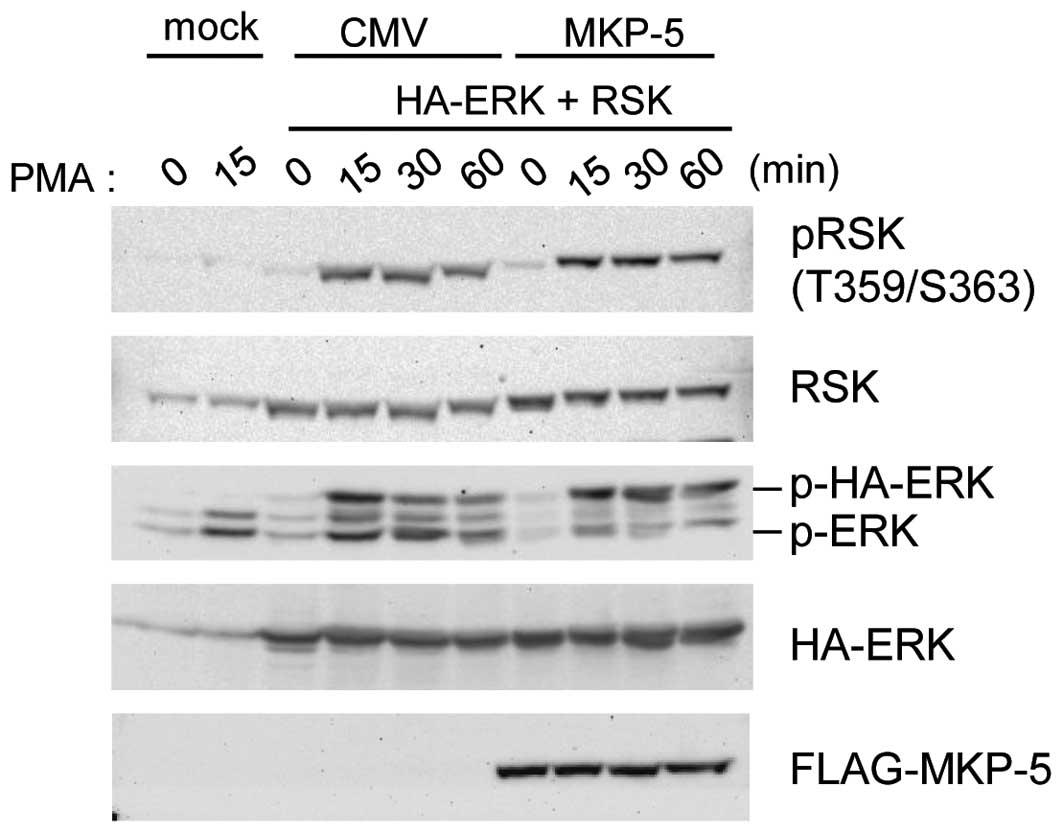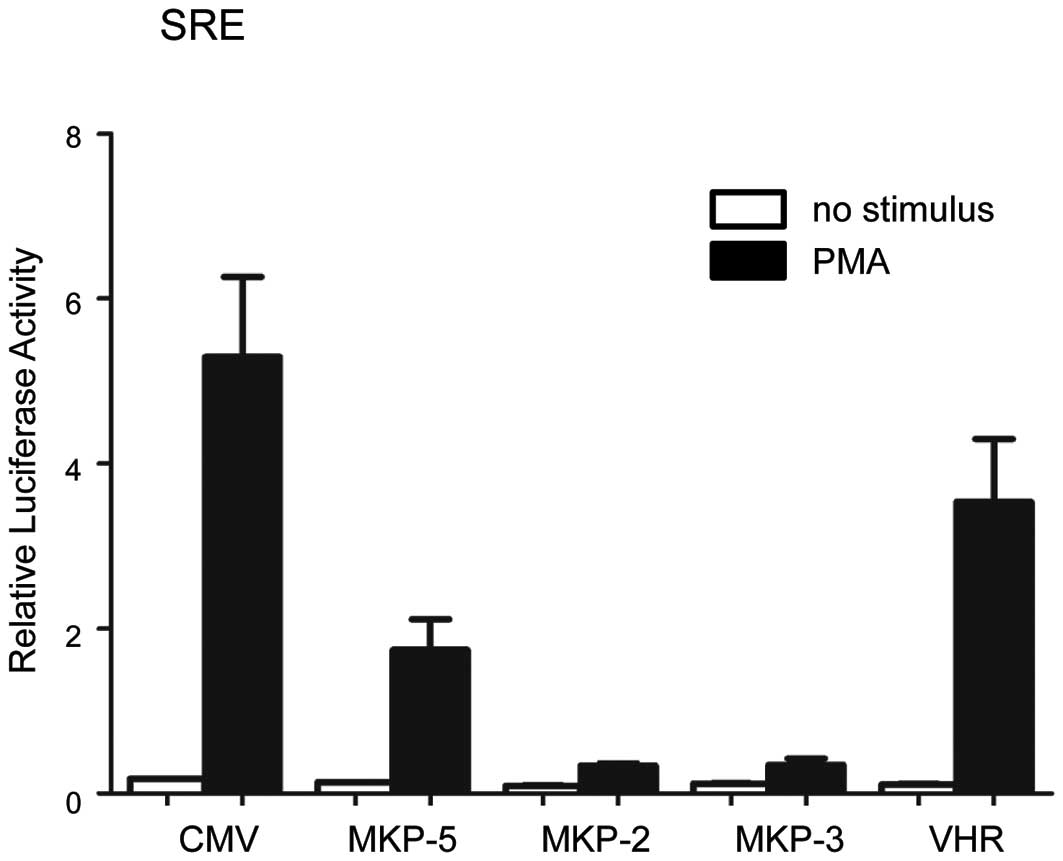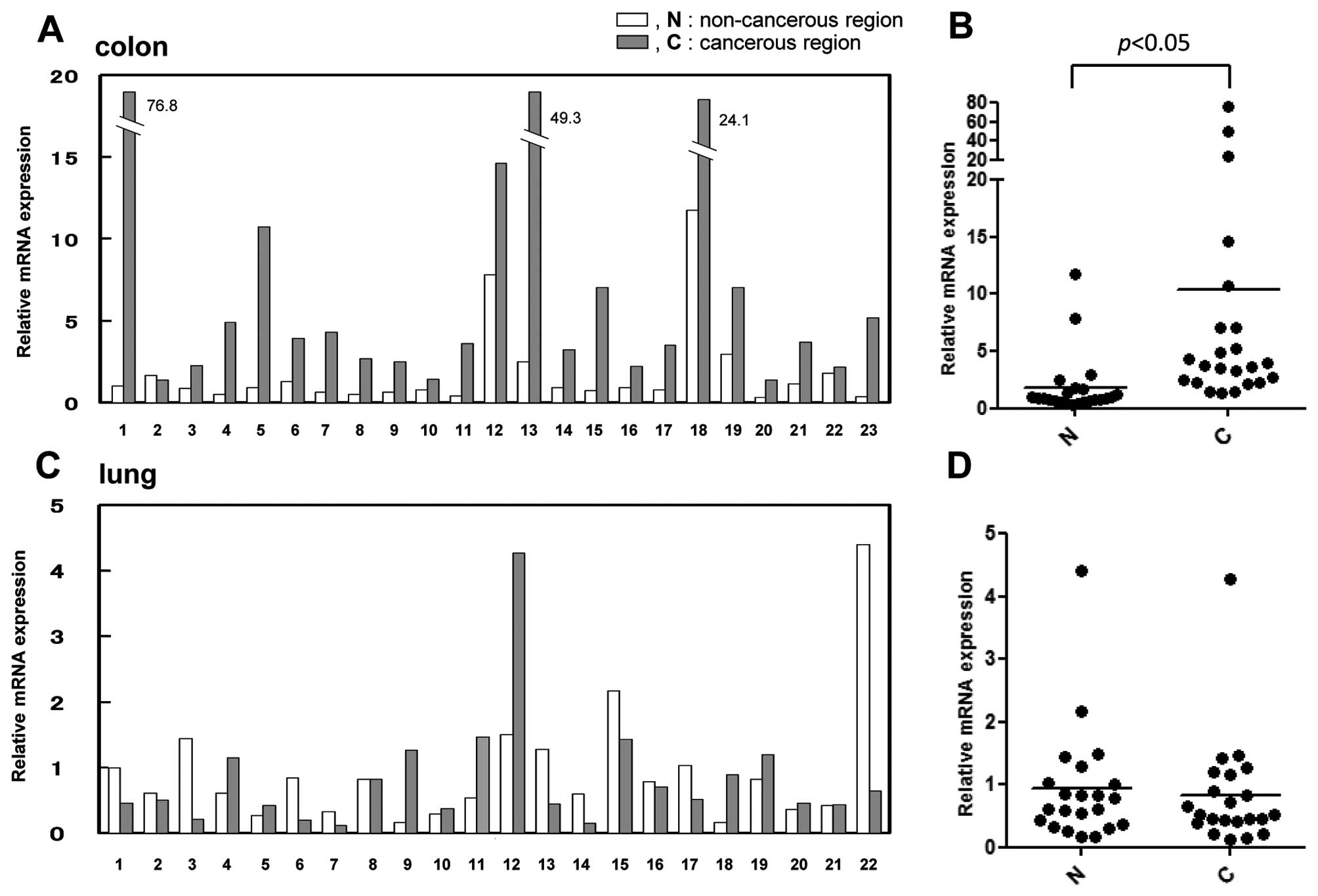Novel function of MKP-5/DUSP10, a phosphatase of stress-activated kinases, on ERK-dependent gene expression, and upregulation of its gene expression in colon carcinomas
- Authors:
- Published online on: June 12, 2012 https://doi.org/10.3892/or.2012.1862
- Pages: 931-936
Abstract
Introduction
Mitogen-activated protein kinases (MAPKs), key signal-transducing enzymes that are activated by a wide range of extracellular stimuli, play an important role in a variety of cellular processes, including proliferation, differentiation and apoptosis (1,2). The MAPK superfamily consists of three major subfamilies, extracellular signal-regulated kinases (ERKs), c-Jun N-terminal kinases (JNKs) and p38 MAP kinases. It is well established that ERK1/2 are typically stimulated by growth-related stimuli, while JNK and p38 are primarily activated by stress-related signals such as UV irradiation, osmotic shock and inflammatory cytokines (1,2).
MAPKs are activated by phosphorylation on both the threonine and tyrosine residues of a conserved T-X-Y motif within the activation loop of the kinase. Negative regulation of MAPKs is achieved by dephosphorylation of the T-X-Y motif by phosphatases (3). There are ten MAPK phosphatases (MKPs) that act as negative regulators of MAPKs. These can be subdivided into three distinct groups (3). Subgroup I contains the inducible nuclear MKPs, MKP-1, MKP-2, PAC1 and hVH-3, which target ERK, JNK and p38. Subgroup II contains ERK-specific cytoplasmic MKPs, encoded by MKP-3, MKP-4 and MKP-X. Subgroup III consists of three p38- and JNK-specific MKPs, encoded by MKP-5/DUSP10, MKP-7 and hVH-5.
The roles of MKPs in the regulation of MAPK pathways in normal cells suggest that the possible pathological consequences of either a loss or gain in the function of these enzymes are part of the oncogenic process (4–7). In addition, MAPK signaling plays a key role in determining the response of tumor cells to conventional cancer therapies (7). There is increasing evidence that some MKPs may be abnormally regulated in certain tumors (4–6). Whether overexpression or loss of expression is a cause of, or contributes to the malignant phenotype rather than simply being a consequence of cell transformation remains ambiguous.
MKP-5 was identified as a phosphatase that selectively inactivates JNK and p38, but not ERK1/2 (8–10). MKP-5 mRNA is widely expressed in various tissues and organs, and its expression in cultured cells is elevated by stress stimuli, such as UV, anisomycin, osmotic stress and tumor necrosis factor-α treatment, which are known to activate JNK or p38 (8,9,11). MKP-5 was also identified as a gene that is induced by DNA double-strand break in an ATM-dependent manner (12). Suppression of MKP-5 induces oligodendrocyte differentiation by regulating ERK function, suggesting an unidentified role in the ERK pathway (13).
To clarify whether or not MKP-5 is a genuine regulator of the JNK and p38 pathways, we analyzed the interactions between MKP-5 and the three MAPKs, JNK, p38 and ERK, and found that it can also interact with ERK. Furthermore, a time course analysis of ERK activation showed that MKP-5 induced, enhanced and prolonged ERK phosphorylation, suggesting an MKP-5 function in the ERK pathway. This data led us to investigate a novel MKP-5 function as a scaffold protein. Accumulating evidence of altered expression in parts of subgroup I and II MKPs in cancer tissues suggests that these phosphatases can act as tumor regulators depending on the cancer type (4–6). In contrast, involvement of subgroup III MKPs in tumor formation and progression has not been thoroughly examined. To obtain insight in the role of MKP-5 in tumor formation, we examined its mRNA expression levels and found that MKP-5 is frequently overexpressed in colon tumors.
Materials and methods
Expression vectors
pFLAG-MKP-2, pFLAG-MKP-3 and pFLAG-MKP-5 have been previously described (10,14). pFLAG-MKP-5CS (C428S), phosphatase dead mutant, was generated by site-directed mutagenesis using the QuikChange site-directed mutagenesis system (Stratagene, Garden Grove, CA, USA) and subcloned into pFLAG-CMV2. pCX4-bleo-RSK1 and pSRα-HA-ERK2 were a gift from Dr T. Akagi (Kan Institute) and Dr M. Karin (University of California, San Diego, CA, USA), respectively. pCMV-β-galactosidase has been previously described (15). pSRE-Luc was obtained from Stratagene.
Cell culture, DNA transfection and stimulation
HeLa, HEK293 and COS-7 cells were maintained in Dulbecco's modified Eagle's medium (DMEM) containing 10% fetal bovine serum (FBS) at 37°C under 5% CO2. Cells were co-transfected with various pFLAG-MKP expression vectors together with pSRα-HA-ERK2, pSRα-HA-JNK1 or pMT3-HA-p38α. For transient assays, cells were transfected using the Fugene-6 transfection reagent (Roche Diagnostics Inc., Manheim, Germany) according to the manufacturer's recommendations. Eighteen hours later, cells were starved for 18 h and then exposed to 10 ng/ml PMA (phorbol 12-myristate 13-acetate; Sigma-Aldrich Corp., Saint Louis, MO, USA) for 15 min or 0.4 M sorbitol for 30 min.
Detection of expressed proteins
Cell lysates were prepared as previously described (10). Samples were separated on 10% SDS-PAGE gels and transferred to nitrocellulose membranes. Expression levels of HA-tagged MAPKs and FLAG-tagged MKPs were monitored using anti-HA (12CA5; Roche Diagnostics, Inc.) and anti-FLAG M2 (Sigma-Aldrich Corp.) monoclonal antibodies, respectively. ERK2 activation was monitored by an anti-phospho-ERK1/2 antibody (Thr202/Tyr204; Cell Signaling Technology, Inc., Danvers, MA, USA). The amount and activation of RSK1 (p90 ribosomal S6 kinase1) were monitored using anti-RSK (BD Biosciences, Franklin Lakes, NJ, USA) and anti-phospho-p90RSK (Thr359/Ser363; Cell Signaling Technology, Inc.) antibodies, respectively. Signals were detected by enhanced chemiluminescence using the ECL reagent (Amersham Pharmacia Biotech, Piscataway, NJ, USA) and Fuji LAS 4000 mini (Fuji Film Co., Tokyo, Japan).
Cell staining
HeLa cells on coverslips coated with Vitrogen 100 (Collagen Biochemical, Palo Alto, CA, USA) were co-transfected with pFLAG-MKP-5 and pSRα-HA-ERK2. Transfected cells were fixed in PBS (phosphate-buffered saline) containing 3.7% formaldehyde for 10 min and then permeabilized with PBS containing 0.5% Triton X-100 for 5 min. After incubation in PBS containing 3% BSA (PBS-B) for 2 h, cells were incubated overnight at 4°C in PBS-B containing an anti-FLAG polyclonal antibody (provided by Dr K. Yamashita, Kanazawa University) to detect FLAG-tagged proteins and an anti-HA antibody to detect HA-tagged proteins. After three PBS washes, cells were incubated for 20 min at 37°C with AlexaFluor 488-conjugated goat anti-mouse IgG (H+L) antibody (Molecular Probes, Eugene, OR, USA) or AlexaFluor 546-conjugated goat anti-rabbit IgG (H+L) antibody (Molecular Probes) in PBS-B. After three PBS washes, coverslips were mounted with PBS containing 90% glycerol. Fluorescence was visualized using a fluorescence microscope.
Reporter analysis
HEK293 cells were transfected with pSRE-Luc together with pCMV-β-galactosidase and MKP expression vectors. Eighteen hours later, cells were serum-starved for 12 h, and then treated with 10 ng/ml PMA. Six hours later, cells were harvested and washed with PBS twice, and then lysed with LCβ lysis buffer (Toyo Ink, Tokyo, Japan). Cell lysates were obtained using a freeze-thaw treatment and centrifugation. Luciferase activity in the lysates was measured with Picagene (Toyo Ink) using MicroLumat Plus LB96V (Belthold, Bad Wildbad, Germany). Luciferase activities were normalized to the activity of the co-expressed β-galactosidase, which was assayed as previously described (15).
Quantitative reverse transcription PCR
Total RNA was prepared from the specimens with Isogen reagent (Nippon Gene, Tokyo, Japan) according to manufacturer's instructions. cDNA was synthesized using an oligo(dt)12–18 primer with Superscript III reverse transcriptase (Invitrogen, Carlsbad, CA, USA) and applied to quantitative real-time PCR (qRT-PCR) using LightCycler 480 (Roche Diagnostics, Inc.) with the universal probe library and probe master kit (Roche Diagnostics, Inc.). The level of MKP-5 mRNA in tumors was expressed as a ratio relative to one surrounding a non-cancerous region.
Statistical analysis
The expression of MKP-5 mRNA in the colon and lung specimens was analyzed by t-test. A difference between the non-cancerous and the cancer portion with P<0.05 was statistically significant.
Results
MKP-5 interacts with ERK
To clarify whether MKP-5 only regulates the JNK and p38 pathways, we compared the interaction of MKP-5 with JNK, p38 and ERK, using the immunoprecipitation method. Compared with FLAG-MKP-2 and FLAG-MKP-3 (belonging to the MKP-subgroup I and II, respectively) FLAG-MKP-5 had a much higher binding specificity to HA-JNK1 and HA-p38α (Fig. 1A-a and b), in accordance with a previous report (3). Interestingly, HA-ERK was co-immunoprecipitated with FLAG-MKP-5, although MKP-5 did not possess ERK phosphatase activity (8,9). The amount of HA-ERK2 that co-immunoprecipitated with FLAG-MKP-5 was similar to the amounts that co-immunoprecipitated with FLAG-MKP-2 and FLAG-MKP-3, both of which preferentially dephosphorylate ERK (Fig. 1A-c). These results indicate that MKP-5 binds ERK similarly to ERK phosphatases such as MKP-2 and MKP-3. Next, we examined the co-localization of FLAG-MKP-5 and HA-ERK in cells (Fig. 1B). Immunostaining with anti-HA antibody showed that after PMA treatment HA-ERK2 was localized primarily in the nucleus (small arrow heads). However, in cells where FLAG-MKP-5 was co-expressed, HA-ERK2 was detected in the cytoplasm (wide arrow heads). This suggests that MKP-5 retains ERK in the cytoplasm even after PMA treatment.
MKP-5 induces enhanced and prolonged PMA-stimulated ERK phosphorylation, without requiring its enzyme activity
To clarify the physiological meaning of the interaction between MKP-5 and ERK, we analyzed the time-course of PMA-stimulated ERK in the presence of MKP-5 in COS-7 cells (Fig. 2). The phosphorylation levels of HA-ERK2 reached maximal levels 15 min after PMA stimulation, and decreased to basal levels by 90 min (Fig. 2, upper panel). However, when FLAG-MKP-5 or FLAG-MKP-5CS, a phosphatase dead mutant, were co-expressed, we observed enhanced and prolonged phosphorylation of HA-ERK2 (Fig. 2, upper panel). In contrast, co-expression of MKP-2 and MKP-3 suppressed ERK activation for at least 90 min after PMA treatment (Fig. 2, lower panel). These results indicate that FLAG-MKP-5 upregulates ERK phosphorylation and that this effect does not require MKP-5 enzyme activity.
Phosphorylated ERK in MKP-5 co-expressing cells is not active
When FLAG-MKP-5 was co-expressed, phospho-HA-ERK2 accumulated (Fig. 2) and was retained in the cytoplasm (Fig. 1B). Thus it is possible that ERK substrates in the cytoplasm are highly phosphorylated. We examined this possibility by comparing phosphorylation levels of Thr-359 and Ser-363 of RSK1, a cytoplasmic ERK substrate, in the presence or absence of FLAG-MKP-5. As shown in Fig. 3, sustained HA-ERK2 phosphorylation was detected in FLAG-MKP-5-expressing cells, while enhanced RSK1 phosphorylation at Thr-359 and Ser-363 was not observed. This data suggests that when bound to MKP-5, phospho-ERK does not phosphorylate RSK1 as much as non-bound phospho-ERK.
MKP-5 prevents ERK-dependent transcriptional activation
The effect of MKP-5 on ERK-dependent transcriptional regulation was analyzed using SRE (serum responsive element)-driven luciferase reporter constructs (Fig. 4). MKP-2 and MKP-3, which dephosphorylate ERK effectively (3), inhibited SRE-dependent transcription almost completely. Under the same conditions, MKP-5 suppressed SRE-dependent transcription by 67%, whereas VHR, a dual-specificity phosphatase that negatively regulates ERK signaling (16) showed 33% inhibition. These results show that MKP-5, which was believed to be a specific regulator of gene expression through the JNK and p38 pathway, also downregulates ERK-dependent gene expression.
Upregulation of the MKP-5 gene in colon carcinoma
Previous data revealed that in addition to the significant negative regulation of the JNK and p38 pathways by phosphatase activity, MKP-5 negatively regulates the ERK pathway as a scaffold protein. This data suggested that, as a whole, the function of MKP-5 on the three MAPK pathways is similar to that of MKP-1 (JNK = p38 > ERK), which is regarded as a tumor regulator according to the cancer type (5,6). To obtain further insight on the role of MKP-5 in tumor formation, we examined the expression levels of the MKP-5 gene in colon carcinoma (Fig. 5A) and lung carcinoma (Fig. 5C). The expression levels of MKP-5 in colon cancerous tissues increased by 5-fold compared to the non-cancerous region of the same samples (Fig. 5B). In contrast, MKP-5 gene expression in lung cancer tissues was relatively similar compared to that of non-cancerous regions (Fig. 5D). In breast cancer and glioblastoma samples, there was no significant change in the expression between tumor and normal samples (data not shown). This data suggests that upregulation of MKP-5 was specific to colorectal carcinoma tissues.
Discussion
In the present study, we found that in addition to JNK and p38, MKP-5 interacts with ERK, and that MKP-5 and its phosphatase-dead mutant enhanced and prolonged mitogen-stimulated ERK phosphorylation. Immunohistological analysis showed that MKP-5 functions as a cytoplasmic anchor for ERK. We also analyzed the physiological consequence of blocking nuclear translocation of phospho-ERK, and found that despite the enhanced levels of phospho-ERK, phosphorylation of the cytoplasmic target RSK was not enhanced. Importantly, MKP-5 suppressed SRE-driven gene expression. These observations indicate that MKP-5 inhibits ERK-dependent gene expression by preventing nuclear translocation of phospho-ERK and preventing phospho-ERK from further phosphorylating and activating RSK1.
Other protein phosphatases also regulate ERK localization (2). Phosphotyrosine phosphatases, such as PTP-SL, STEP and He-PTP, retain ERK in a dephosphorylated form in the cytoplasm by tyrosine dephosphorylation. MKP-3/DUSP6 also functions in cytoplasmic retention of dephosphorylated ERK2. Therefore, these phosphatases may function to dephosphorylate and regulate ERK. In contrast, MKP-5 may function as a scaffold protein and not as a phosphatase to anchor ERK in the cytoplasm.
Temporal and spatial control of MAPK signaling is regulated by protein scaffolds (17,18). Two proteins, PEA-15 and SEF, have been identified as cytoplasmic anchors for ERK2 (18). Both can retain ERK2 in the cytoplasm in the active state, indicating that they may act to restrict ERK2 activity to cytoplasmic targets. In contrast, our data indicates that MKP-5 does not lead to enhanced RSK1 phosphorylation. Therefore, the MKP-5 interaction may inhibit the kinase activity of ERK, or MKP-5 may occupy the ERK substrate recognition site. In our study, MKP-5 induced enhanced and prolonged phosphorylation of ERK. As PEA-15 induces prolonged ERK phosphorylation (19), this activity may be a common characteristic of ERK cytoplasmic scaffold proteins (18). It is likely that cytoplasmic retention prevents phospho-ERK from dephosphorylation by nuclear phosphatases, such as MKP-1 and MKP-2.
To our knowledge, this is the first report demonstrating the analysis of MKP-5 expression in malignant tissues. We examined its expression levels in colon carcinoma, lung carcinoma, breast cancer and glioblastomas. Overexpression of the MKP-5 gene was observed in colon carcinoma, but no significant up- or downregulation was observed in lung carcinoma, breast cancer and glioblastomas. It is unclear whether this overexpression in colon carcinoma is a cause of or consequence of cell transformation. With respect to the stress-activated MAP kinases, their role in cancer can be complex, but JNK and p38 may act as tumor suppressors in vivo(7). Since MKP-5 is a specific JNK and p38 phosphatase, this overexpression may direct cell transformation by abrogating JNK and p38 activity. On the other hand, it is also accepted that the ERK pathway is associated with the ability of cancer cells to grow. In this study, we found that MKP-5 negatively regulated ERK-dependent gene expression. MKP-5 gene expression may be elevated as a negative feedback mechanism to counteract ERK activation. Importantly, data suggested that anti-inflammation activity by vitamin D and curcumin is mediated by MKP-5, which is a potential mechanism for prostate cancer prevention (20,21). In the mouse model of colon cancer, which was induced by azoxymethane and dextran sulfate sodium, ERK phosphorylation was significantly increased by about 10-fold (22). The vitamin D analog suppressed this ERK phosphorylation and progression to cancer. We believe that the present findings on the novel function of MKP-5 will aid in the utilization of MKP-5 as a molecular target for cancer prevention and therapy.
Evidence presented in our study strongly suggest that MKP-5, a JNK and p38 phosphatase, inhibits ERK-dependent gene expression by blocking nuclear accumulation of phospho-ERK and suppressing activation of phospho-ERK as a kinase. These findings suggest that deregulation of MKP-5 expression may affect the cross-talk between stress signaling and ERK signaling in these cancer tissues, and is associated with the malignant phenotype of colon tumors.
Acknowledgements
We thank Dr K. Yamashita (Kanazawa University) for the anti-FLAG antibody. We thank Dr M. Karin (University of California) for pSRα-HA-ERK2. This study was supported in part by grants-in-aid for Scientific Research (Challenging Exploratory Research, B and C) provided by the Japan Society for the Promotion of Science (to K.-I.S., Masami Sato and H.S.).



